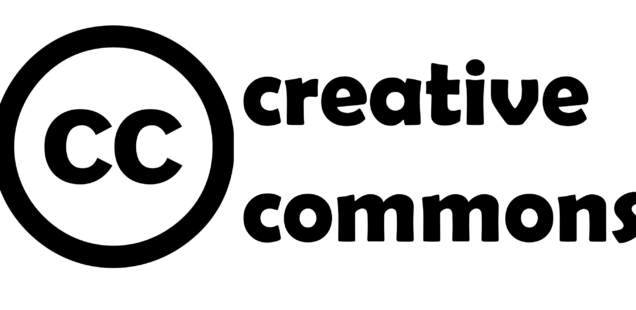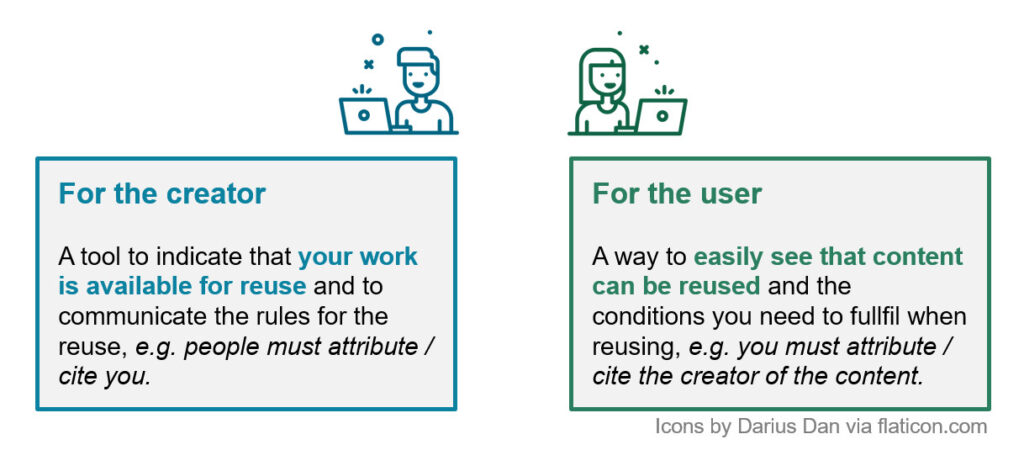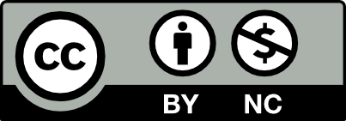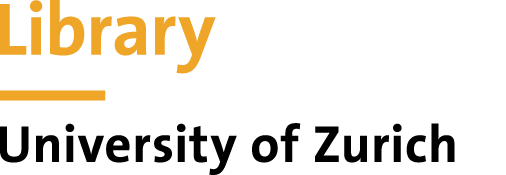
Creative Commons licenses in a nutshell
Read this post in
 Deutsch
Deutsch
As the copyright holder of a scientific work you can share it openly with a Creative Commons license. What are Creative Commons licenses?
If you want to make your scientific work (text, code, data, study protocols, etc.) publicly available, you can either use an open-access publication channel (e.g., open-access journal) or self-archive your work. For self-archiving, you deposit your work in a recognized repository and specify how others may reuse it. For this, you choose a license.
Why licenses?
By choosing a license for their published work, researchers make clear how their work may be reused. This makes it clear to others how and under which conditions reuse is possible. Thanks to clear license information, it is no longer necessary to contact the authors of a work to find out whether further use would be permitted. This significantly increases the reusability of the work and also its value.

Licenses are legally binding: if users do not adhere to the stated conditions (such as attribution), they are committing copyright infringement and can be sued for it by the licensors.
For the majority of works generated in a research environment, the so-called Creative Commons licenses can be used. Among other things, they are suitable for images, data sets and presentations, as well as for entire e-books and journal articles. For the publication of code or software, however, other licenses are more suitable, such as the GNU licenses (https://www.gnu.org/licenses/) or the MIT license (https://opensource.org/license/mit/).
What are the Creative Commons licenses?
Creative Commons provides four elements in its licenses that can be combined in different ways. This results in six different licenses.
With most licenses, the work can not only be reused, but also modified, and the modified work may in turn be re-shared for any reason and in any way. However, some licenses also restrict further use.
 | If a work has a CC-BY license, users can continue to use it for all purposes, change the work, adapt it, etc. The only condition: you must cite the original work (BY = ATTRIBUTION). |
 | With the CC-BY-SA license, users can modify and redistribute the published work, but they must credit the original author or cite the work (ATTRIBUTION), and license the new version with CC-BY-SA as well. (SA = SHARE ALIKE) |
 | With the CC-BY-ND license, users may not modify the work (ND = NO DERIVATIVES) and must cite the original work when using it (ATTRIBUTION). This license is suitable, for example, if one wants to allow reproduction studies without changing the dataset. |
 | With the CC-BY-NC license, users may not use the work for commercial (NC = NON-COMMERCIAL) purposes, and must cite the original work (ATTRIBUTION). However, they may modify the work and re-share it modified (but not for commercial purposes). |
 | With the CC-BY-NC-SA license, users must: 1) cite the original work, 2) not use the work for commercial purposes, 3) share their modified work with the same license. However, modifications are allowed. |
 | CC-BY-NC-ND is the most restrictive license: the work may not be modified or used for commercial purposes and the original work must be cited. |
Which license is best for me?
It is up to each individual to decide which license is best for their own work:
- Do I want my work to remain open in the future? Then I choose CC-BY-SA – the license recommended for Wikimedia Commons. With this license, all future users must also share their work openly (with a CC-BY-SA license) and cannot use the content for commercial purposes (e.g. sell it).
- Do I not want my work to be used for commercial purposes? Then I choose a license with the NC component, e.g. CC-BY-NC. Beware: any context where money changes hands is considered “commercial”.
- Do I want others to be able to reuse my datasets and integrate them into their datasets? Or do I only want to allow reuse without customization? With the ND component, I can restrict reuse here.
Would you like to know more?
Check out our website for more information on Creative Commons licenses and copyright.
Melanie Röthlisberger, Open Science Services
Anna Véron, Liaison Librarian Naturwissenschaften

Comments are closed, but trackbacks and pingbacks are open.